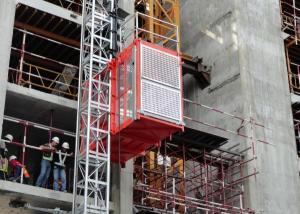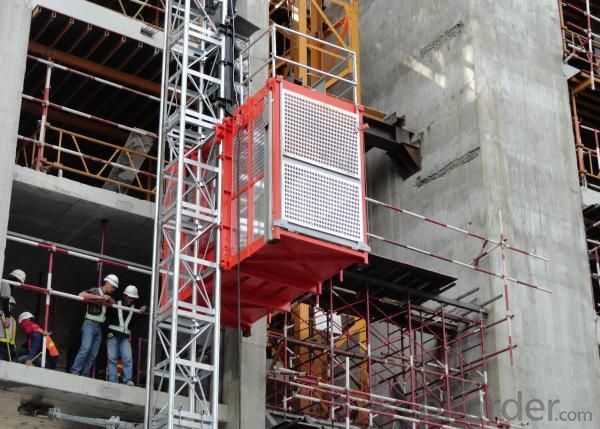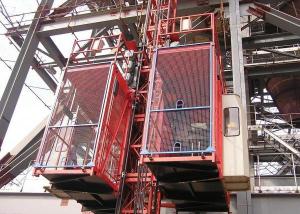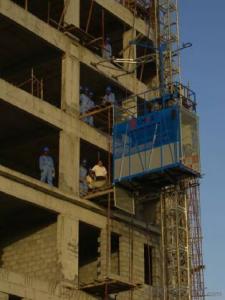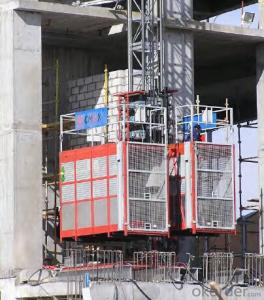Building Hoist SC120
- Loading Port:
- China Main Port
- Payment Terms:
- TT or L/C
- Min Order Qty:
- 1 Set set
- Supply Capability:
- 90 Sets Per Month set/month
OKorder Service Pledge
OKorder Financial Service
You Might Also Like
Building Hoist SC120 Technical Data
|
Lifting capacity |
1200kg |
|
Lifting speed |
33 m/min, 38m/min, 0-60m/min (VVVF+PLC), 0-90m/min (VVVF+PLC) |
|
Max. lifting height |
300m |
|
Motor type |
Chinese motor or SEW motor |
|
Anti-drop safety device |
With our patent |
|
Cage size (L x W x H) |
Recommended size: 2.5x1.2x2.4m. We can also manufacture the cages of other sizes according to the clients. |
|
Mast section |
650x650x1508mm, hot dip galvanized or paint-sprayed. |
|
Anchor |
Distance 6-9m, hot dip galvanized or paint-sprayed. |
|
★Thewhole machinecan be designed according to your specific requirements | |
Details of Hoist SC120 Technical Data
Building Hoist SC120 manufactured by our company have the features as good quality, long life, wide application range and convenient for maintenance.
The gearing adopts imported bearing, enameled cable, and oil seal.
The electric parts adopt products from world renowned manufactures such as Schneider, Siemens, and LG.
The racks amd pinion adopts special material and heat-treatment technique, which prolong the life of these parts.
The steel structure uses quality steel from famous domestic manufacturers. The surface of the structure can apply paint-spray, parkerizng baking finish or hot galvanizing processing according to users requirements.
We can also manufacture cages of other size according to the user
The cage and the door material can be aluminum molded board, punched-plate,figured aluminum board or other type according to your requirementes
The mast and the tie-in surface can adopt paint-spray, or hot galvanizing processing.
We has passed ISO9000 quality system authentication.
We have powerful R&D centre and professional customer support team.
Excellent quality and service are what we actually supply with.
Packaging & Delivery
Package: nude and wooden boxes in containers.
Period of shipment: 30 days after receipt of the buyer's advance payment.
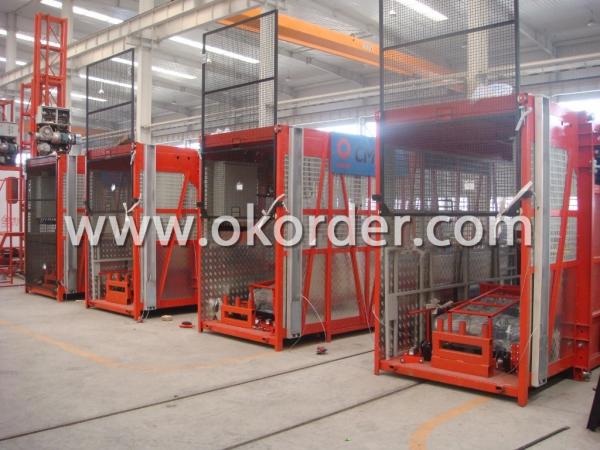
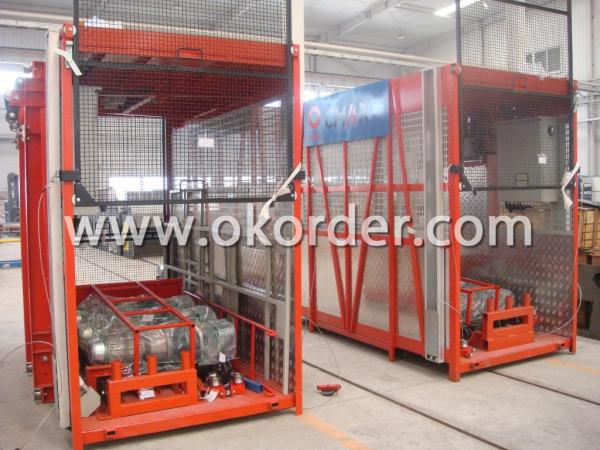
- Q: Can a building hoist be utilized for the purpose of lifting heavy machinery and what are the considerations for such usage?
- <p>Yes, a building hoist can be used for lifting heavy machinery, but it must be designed for that specific purpose and have the appropriate capacity to handle the weight of the machinery. It's crucial to ensure the hoist meets safety standards and is operated by trained personnel. The machinery's size, weight, and the hoist's lifting height and stability are all factors to consider. Always follow the manufacturer's guidelines and local regulations to prevent accidents.</p>
- Q: This question asks for the steps or methods to change the height at which a building hoist operates.
- <p>To adjust the height of a building hoist, follow these steps: Ensure the hoist is powered off and unplugged. Locate the height adjustment mechanism, which is typically a set of bolts or a telescoping system. Loosen any locking nuts or bolts to allow movement. Adjust the hoist height by raising or lowering the platform to the desired level. Once the correct height is reached, tighten the nuts or bolts to secure the hoist in place. Test the hoist to ensure it operates safely at the new height. Always refer to the manufacturer's instructions for specific details on your hoist model.</p>
- Q: This question asks whether a hydraulic building hoist can be used in both indoor and outdoor environments and seeks reasons for its versatility.
- <p>A hydraulic building hoist can be used both indoors and outdoors. These hoists are designed to be versatile and durable, capable of withstanding various weather conditions when used outdoors. They are also compact and can be easily maneuvered in indoor spaces. The primary reason for their versatility is the robust construction and the ability to handle different loads with precision. Additionally, hydraulic systems are less affected by electrical interference, making them suitable for environments with fluctuating power supplies. However, it's important to ensure that the hoist is properly maintained and protected from extreme weather conditions to prolong its lifespan and ensure safety.</p>
- Q: The user is asking if it's possible for them to fix their own building hoist without professional assistance.
- <p>While it is technically possible to repair your own building hoist, it's generally not recommended unless you have specific expertise in hoist maintenance and repair. Building hoists are complex mechanical systems that require knowledge of safety regulations and proper repair techniques. Attempting repairs without proper training can lead to accidents or further damage. It's best to hire a professional who is familiar with the specific model and has the necessary certifications to ensure the hoist is safe and functioning correctly.</p>
- Q: Is it possible to use a building hoist for the purpose of lifting heavy objects?
- <p>Yes, a building hoist can be used for lifting large objects. These hoists are specifically designed to handle heavy loads and are commonly used in construction for lifting materials, equipment, and other heavy items. They are engineered with safety features to ensure secure lifting and are operated by trained personnel. However, it's crucial to ensure the hoist's capacity matches the weight of the object being lifted and that all safety protocols are followed to prevent accidents.</p>
- Q: Is it possible to replace a building hoist with an electric winch for the purpose of lifting materials or individuals?
- <p>While theoretically possible, using an electric winch instead of a building hoist for lifting materials or people is not recommended due to safety concerns and differences in design. Electric winches are typically designed for pulling or towing loads and may not have the necessary safety features, load capacity, or stability required for lifting operations in a construction setting. Building hoists are specifically engineered to lift heavy materials and personnel safely in vertical shafts or on the facade of a building. They are equipped with safety devices and are regulated for construction use, making them the appropriate choice for such tasks.</p>
- Q: What are the financial expenses associated with buying and keeping a building hoist in good condition?
- <p>The costs of purchasing and maintaining a building hoist include the initial purchase price, which can range from $10,000 to $50,000 depending on the hoist's capacity and features. Maintenance costs involve regular inspections, lubrication, and part replacements, averaging around $1,000 to $3,000 per year. Operating costs include labor for hoist operation and potential rental fees if the hoist is not owned. Additionally, there may be costs for safety training and compliance with regulations. These costs can vary widely based on the specific hoist model, usage frequency, and local regulations.</p>
- Q: What precautions should be taken when using manual lifting equipment to ensure safety?
- <p>Safety measures for using manual lifting devices include inspecting equipment for damage before use, ensuring the load is within the device's weight capacity, using proper lifting techniques, maintaining a clear path for lifting, and securing the load to prevent shifting. Always wear appropriate personal protective equipment, such as gloves and safety shoes. Never exceed the rated capacity of the lifting device, and avoid sudden or jerky movements that could cause loss of control. Regular maintenance and training on safe lifting practices are also crucial to prevent accidents.</p>
- Q: This question asks for a comparison of vertical and horizontal lifting in the context of building hoists, highlighting their distinct characteristics.
- <p>Vertical lifting in a building hoist refers to the movement of materials directly up or down, which is essential for transporting goods between different floors or levels of a building under construction. Horizontal lifting, on the other hand, involves moving materials across a horizontal plane, which is useful for moving items along a floor or between different parts of a construction site. Vertical lifting is typically more common in hoists due to the nature of building construction, requiring frequent vertical transport. Horizontal lifting is less common but can be implemented with specialized equipment or by combining vertical and horizontal movements. The choice between vertical and horizontal lifting depends on the specific requirements of the construction project and the layout of the site.</p>
- Q: Helped wall bar how to set up, and several layers of set a, two width, wall rod need a few meters long, what shape is the embedded parts, how much of a steel bar, Angle and wall vertical or have?
- In the construction preparation stage, must first be familiar with the steel stair construction drawing and construction drawings of embedded object, combined with the site construction conditions, to understand the distribution of the embedded parts of this project, form, and according to the construction characteristics of the project construction scheme of embedded object, technical disclosure, etc.
Send your message to us
Building Hoist SC120
- Loading Port:
- China Main Port
- Payment Terms:
- TT or L/C
- Min Order Qty:
- 1 Set set
- Supply Capability:
- 90 Sets Per Month set/month
OKorder Service Pledge
OKorder Financial Service
Similar products
Hot products
Hot Searches
Related keywords
